The Emerging Role of Haptics in Breathwork and Wellness Devices

Haptic technology is becoming a powerful tool for managing stress and supporting emotional well-being. Research suggests that a well‑timed vibration on the skin can anchor attention just as reliably as guided audio or medication (source) (source).
By turning touch into a gentle guide, haptics create a quiet, intuitive way to stay present. Pulses delivered through a wearable, phone, or handheld device can subtly cue each inhale and exhale, helping users regulate their breathing without relying on screens or sound. This shift from external distractions to tactile awareness allows users to reconnect with their bodies and stay grounded in the moment.
As global stress continues to climb, there’s a need for simple, unobtrusive tools that help us return to center wherever we are: on a bus, in an open office, or winding down before bed.
Today, we’ll explore the benefits of vibration on breathwork and discover how wellness innovators are utilizing haptics to help users more fully engage with the benefits of mindfulness and meditation practices.
Haptic Feedback and the Vagus Nerve Connection
Vibration has long been known for its health benefits. Recent years have seen advances in haptic devices specifically designed to enhance breathwork. Examples include shirts that guide wearers through breathing exercises with vibrotactile feedback, and wearables that’s designed to regulate the nervous system by stimulating vagus nerve activity.
These devices are capable of linking with apps and combine breathing exercise and meditative experiences with haptic vibrations. Many also track breathing metrics and learn what works best for the user, resulting in a more personalized experience.
These innovations align with the thinking of many neuroscientists, who feel that stimulating or “toning” the vagus nerve is the key to unlocking the relaxation response (source).
Why is this important? According to Scientific American, the vagus nerve is the most interconnected in the body, influencing heart rate, inflammatory response, mood, and digestion. You might think of the vagus nerve as the brain’s messenger, transmitting information between body functions and the brain. It signals the brain to changes in the body, and the brain sends messages back through the vagus nerve to “rest and digest,” relaxing the system (source).
A well-toned vagus nerve is associated with lower heart rate variability and better mental and physical health, supporting breathwork as a critical intervention in the effort to improve overall wellness through vagus nerve stimulation. One can conclude from this that a device that simplifies the breathwork practice could be incredibly beneficial, providing an easy entrée into a holistic and sustainable health practice.
Benefits of Using Vibration to Support Breathwork
For product teams developing tools for mindfulness and breathwork, haptic vibration cues offer a subtle way to build focus and breath awareness, helping users feel the benefits even in early sessions.
A gentle buzz on the sternum during meditation—from a smartphone, smartwatch, or wearable —can guide users in learning to pace their inhales and exhales.
For beginners, haptics could be a real game-changer, making breathwork easier to stick with. A haptic vibration on the chest or wrist gives the body a physical “marker” to lock onto, making it easier to stay aware of each inhale-exhale cycle without constantly checking a screen, mentally counting, or needing guidance from an instructor.
Haptics can also facilitate specific types of breathing exercises, such as the 4-7-8 technique, box breathing (inhale for four seconds, hold for four seconds, exhale for four seconds), or ujjayi breathing, which is often a component of yoga practice.
A steady buzz (e.g., one long pulse to inhale, two short pulses to exhale) offloads timing from the brain, lowering cognitive load and letting users close their eyes and relax into diaphragmatic breathing instead of focusing on numbers or on-screen visuals.
The tactile prompts that haptics provide also support individuals with visual or auditory impairments, language barriers, or attention deficit challenges, expanding the benefits of breathwork to a broader audience, some of whom may not be willing or able to join a class or access online instruction.
Final Thoughts
Over the past few years, haptics has grown from a gaming curiosity into an everyday technology. More and more companies are finding ways to integrate tactile feedback into phones, wearables, and wellness products, adding a physical layer that turns digital moments into tangible ones.
This same tactile layer can meet a rising demand for accessible self-care tools. In wellness, touch-based cues deepen practice through an interface that is quiet, intuitive, and personal. Gentle vibrations replace spoken or visual prompts, grounding attention and adjusting to each breath in real time. Because haptics already lives inside many consumer devices, wellness brands can adopt it with minimal hardware change while offering real life benefits to their users.
If you’re interested in exploring the potential of haptics for your wellness products, or want to learn more about our reference designs, get in touch today.
Related Articles
The Power of Haptics: Elevating Wellness to the Next Level
Unlocking Wellness Through Touch: The Untapped Potential of Haptics
React at the Speed of Touch: How Haptics Can Improve Reaction Time
